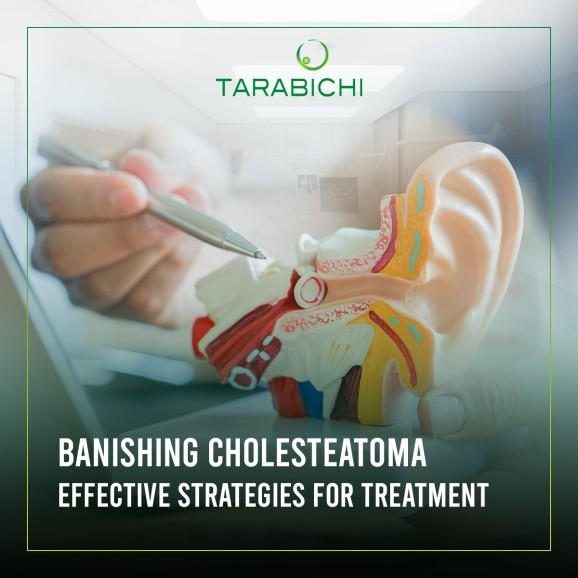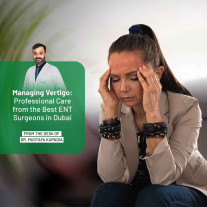Banishing Cholesteatoma: Effective Strategies for Treatment
Contact Us
Have you ever heard about Cholesteatoma? Cholesteatoma is an ear condition that demands attention and understanding.
In this article; we will delve into the causes, symptoms, and treatment options for cholesteatoma, shedding light on this often misunderstood condition.
What is Cholesteatoma?
Cholesteatoma is a medical condition characterized by the abnormal growth of skin tissue in the middle ear, It typically manifests as a cyst or a sac-like structure that gradually expands over time and it can lead to various complications and affect the functioning of the ear.
Cholesteatomas are often the result of repeated ear infections, trauma to the ear, or a malfunctioning Eustachian tube, which is responsible for equalizing pressure between the middle ear and the outer environment.
Causes of cholesteatoma
Cholesteatoma can have several causes, and understanding them is crucial for proper treatment and prevention, here are the primary factors known to contribute to the development of cholesteatoma:
- Chronic Ear Infections:
Prolonged or recurrent infections in the middle ear can lead to cholesteatoma, these infections can cause inflammation and damage to the eardrum, creating an environment favorable for the growth of abnormal skin cells.
- Eustachian Tube Dysfunction:
The Eustachian tube connects the middle ear to the back of the throat, regulating air pressure and draining fluids.
When the Eustachian tube fails to function correctly, it can result in a vacuum-like effect in the middle ear, it is therefore negative pressure can cause the eardrum to retract, forming pockets where cholesteatoma can develop.
- Congenital (Birth) Defects:
In some cases, cholesteatoma can be present at birth or develop shortly afterward due to abnormalities in the structure of the ear, these defects can create spaces where skin cells can accumulate and form cholesteatoma.
- Trauma or Injury:
Head injuries, skull fractures, or other trauma to the ear can disrupt the normal anatomy and promote the growth of cholesteatoma.
- Previous Middle Ear Surgeries:
Individuals who have undergone previous ear surgeries, such as tympanoplasty or mastoidectomy, may have an increased risk of developing cholesteatoma.
The surgery itself can disrupt the delicate balance and structure of the middle ear, potentially leading to the formation of cholesteatoma.
Cholesteatoma symptoms
Cholesteatoma can cause a variety of symptoms, which can vary in severity depending on the size and progression of the growth. Here are some common symptoms associated with cholesteatoma:
- Ear Pain (may range from mild discomfort to sharp).
- Deafness.
- Ear Drainage.
- Tinnitus (a ringing, buzzing, or other similar noises in the ear.
- Dizziness and Balance Issues, vertigo, and problems with balance.
- Recurrent Ear Infections.
- Fullness or Pressure Sensation.
Complication of cholesteatoma
Cholesteatoma can lead to various complications if left untreated or if the growth becomes extensive, some of the potential complications associated with cholesteatoma include:
Hearing Loss:
As cholesteatoma enlarges and progresses, it can erode or damage the delicate structures of the middle ear responsible for transmitting sound waves, and this can result in conductive or mixed hearing loss, which can range from mild to severe.
Balance Problems:
Cholesteatoma can affect the balance organs in the inner ear, leading to dizziness, vertigo (a spinning sensation), and problems with balance, which his can significantly impact a person's quality of life and increase the risk of falls.
Facial Nerve Damage:
In some cases, cholesteatoma can erode the bone surrounding the facial nerve, which controls facial movement, if the facial nerve is affected, it can result in facial weakness or paralysis on the affected side of the face.
Meningitis:
If the infection from the cholesteatoma spreads to the surrounding structures and reaches the protective membranes covering the brain and spinal cord, it can cause inflammation and infection of the meninges (meningitis).
Intracranial Complications:
In severe cases, cholesteatoma can extend into the skull and affect the brain or its surrounding structure.
Spread of Infection:
Cholesteatoma can extend beyond the middle ear and spread infection to nearby structures, such as the mastoid bone or the temporal bone.
Treatment of cholesteatoma
The only treatment for cholesteatoma is surgery, surgery usually involves removing the cholesteatoma and repairing the eardrum.
In some cases, the mastoid bone behind the ear may also need to be removed.
The type of surgery that is performed will depend on the size and location of the cholesteatoma, as well as the patient's overall health.
Cholesteatoma surgery
Some of the most common types of surgery for cholesteatoma include:
- Tympanoplasty: This surgery repairs the eardrum and removes the cholesteatoma.
- Mastoidectomy: This surgery removes the mastoid bone behind the ear, which is where the cholesteatoma often grows.
- Canal wall-up tympanomastoidectomy: This surgery removes the cholesteatoma, but the canal wall is left in place.
- Canal wall down tympanomastoidectomy: This surgery removes the cholesteatoma, the eardrum, and the canal wall.
Here are some additional things to keep in mind about the treatment of cholesteatoma:
- The surgery may be performed under general anesthesia or local anesthesia.
- The surgery usually takes 2 to 3 hours.
- You will need to stay in the hospital for one to two days after surgery.
- You will need to wear a bandage over your ear for one to two weeks after surgery.
- You will need to avoid getting your ear wet for six weeks after surgery.
- You will need to follow up with your doctor regularly.
Also read:
Keloids and hypertrophic scars | identify the difference!
Breaking the Silence: The Benefits of Cochlear Implants.
How is a cholesteatoma diagnosed?
Cholesteatoma is diagnosed by a doctor, usually an ear, nose, and throat (ENT) specialist, the doctor will examine the inside of your ear with an otoscope, a small instrument with a light and magnifying lens.
The doctor may also order imaging tests, such as a computed tomography (CT) scan or a magnetic resonance imaging (MRI) scan, to get a better look at the cholesteatoma and the surrounding structures.
Cholesteatoma radiology
Several imaging techniques can provide valuable information about the extent, location, and characteristics of the cholesteatoma, here are some common radiological methods used in the assessment of cholesteatoma:
- Computed Tomography (CT) Scan:
CT scan is commonly employed to visualize the temporal bone, which includes the structures of the ear.
It provides cross-sectional images that can help identify the presence of cholesteatoma, evaluate its size, location, and involvement of surrounding structures, and assess any complications, such as erosion of bone or involvement of the facial nerve.
- Magnetic Resonance Imaging (MRI):
MRI is particularly useful for assessing soft tissue structures and can provide detailed information about the extent and location of cholesteatoma.
It is often employed when there is a suspicion of intracranial complications or to assess the relationship between cholesteatoma and the facial nerve.
- High-Resolution Temporal Bone CT Scan:
This type of CT specializes in focusing specifically on the temporal bone and provides highly detailed images of the structures within the ear.
It allows for a closer examination of the middle ear, mastoid bone, and associated structures, aiding in the detection and characterization of cholesteatoma.
- Cone Beam CT:
Cone Beam CT is a specialized form of CT imaging that provides three-dimensional images of the temporal bone.
It can provide detailed information about the anatomy and pathology of the ear, including cholesteatoma.
Overall, radiological imaging techniques can help guide treatment decisions, assist in surgical planning, and monitor the progression or recurrence of cholesteatoma over time.
You can also view:
If you are looking for the Best ENT Doctor in Dubai or the Best ENT Specialist in Dubai, please reach out to us on the below details, our team comprises of only the best ent doctors in UAE and the region.




